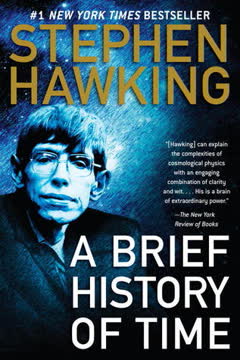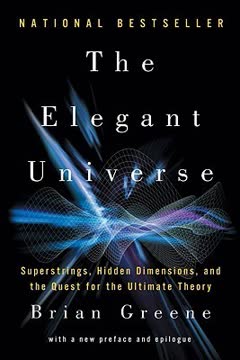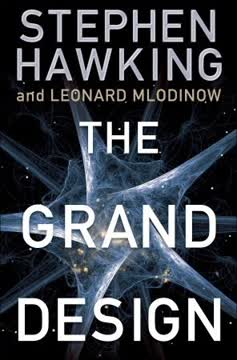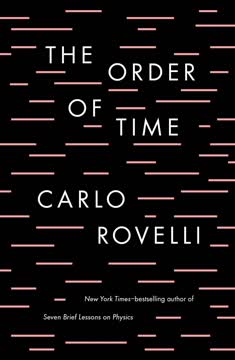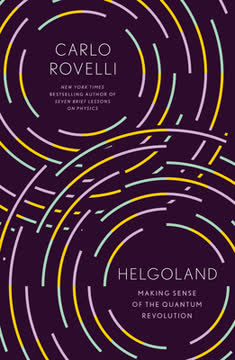重点摘要
1. 爱因斯坦的广义相对论革命性地改变了我们对空间、时间和重力的理解
爱因斯坦写了一个方程,表明R等同于物质的能量。也就是说:有物质的地方,空间就会弯曲。就是这样。这个方程只占半行,没有更多的内容。
重力作为弯曲的时空。 爱因斯坦的突破性见解是,重力不是一种力,而是时空本身的弯曲。这一优雅的概念解释了以下现象:
- 行星轨道:行星绕太阳运动的椭圆路径是因为它们遵循了由太阳质量创造的时空自然弯曲。
- 光线弯曲:像恒星这样的大质量物体可以弯曲经过它们附近的光线,这一效应在日食期间被观察到。
- 时间膨胀:在更强的引力场中,时间流逝得更慢,这一现象通过不同海拔的精密原子钟得到了证实。
预测和验证。 广义相对论做出了一些惊人的预测,这些预测后来得到了验证:
- 黑洞:时空中的区域,重力如此强大,以至于没有任何东西,包括光线,都无法逃脱
- 引力波:由大质量加速物体引起的时空涟漪,首次在2015年被探测到
- 宇宙膨胀:该理论的方程自然引出了宇宙膨胀的概念,后来通过观测得到了证实
2. 量子力学揭示了亚原子世界的奇异概率性质
海森堡设想电子并不总是存在。它们只有在有人或某物观察它们时,或者更好地说,当它们与其他东西相互作用时才存在。
波粒二象性。 量子力学揭示了像电子和光子这样的亚原子实体可以表现为粒子和波,这取决于它们如何被观察。这导致了一些违反直觉的概念,例如:
- 不确定性原理:不可能同时确切地知道一个粒子的位置和动量
- 叠加态:粒子可以在被观察之前同时存在于多个状态
- 量子隧穿:粒子可以穿过经典物理学认为它们不应该能够穿过的障碍
概率性质。 与经典物理学不同,量子力学处理的是概率而不是确定性:
- 波函数:描述量子系统的所有可能状态
- 波函数坍缩:在测量时,系统“选择”其中一个可能状态
- 纠缠:粒子可以变得“纠缠”,一个粒子的状态会立即影响另一个粒子,无论距离多远
3. 宇宙:从平坦的地球到数十亿星系的膨胀宇宙
宇宙开始时是一个小球,然后爆炸到现在的宇宙规模。这是我们目前对宇宙的最大尺度的图像。
宇宙学的演变。 我们对宇宙的理解随着时间的推移显著扩展:
- 平坦的地球和上方的天空
- 以地球为中心的球形宇宙
- 以太阳为中心的太阳系
- 银河系是众多星系之一
- 起源于大爆炸的膨胀宇宙
当前模型。 现代宇宙学模型包括:
- 大爆炸:宇宙大约在138亿年前以极热、极密的状态开始
- 宇宙膨胀:早期宇宙的快速膨胀时期
- 暗物质和暗能量:构成宇宙大部分质量和能量的神秘成分
- 宇宙微波背景辐射:早期宇宙的剩余辐射,为大爆炸提供了证据
4. 基本粒子:所有物质和能量的构建块
因此,我们触摸到的一切都是由电子和这些夸克组成的。
标准模型。 当前的粒子物理理论描述了基本粒子和力:
粒子:
- 夸克:六种类型,组合形成质子和中子
- 轻子:包括电子和中微子
- 玻色子:传递力的粒子,如光子和胶子
力:
- 强核力:将夸克结合在一起
- 弱核力:负责放射性衰变
- 电磁力:带电粒子之间的相互作用
- 重力:尚未纳入标准模型
量子场论。 粒子被视为充满整个空间的基本量子场的激发。这一框架有助于解释现象如:
- 虚粒子:短暂出现和消失的粒子
- 粒子-反粒子对:物质和反物质的自发创造和湮灭
5. 量子引力:将广义相对论和量子力学结合的持续探索
环量子引力是将广义相对论和量子力学结合的努力。这是一种谨慎的尝试,因为它只使用了这些理论中已经包含的假设,经过适当重写以使它们兼容。
不兼容性问题。 广义相对论和量子力学在各自领域都非常成功,但它们在根本上是不兼容的:
- 广义相对论:将重力描述为时空的平滑、连续的弯曲
- 量子力学:以离散量子和概率描述世界
量子引力的研究方法:
- 弦理论:提出基本粒子实际上是多维空间中的微小振动弦
- 环量子引力:建议空间本身被量化为称为“环”的离散单位
- 因果集理论:将时空建模为具有因果关系的离散事件集
挑战和意义。 发展量子引力理论可能:
- 解释黑洞奇点的本质
- 提供宇宙起源的见解
- 将所有基本力统一到一个框架中
6. 时间的本质:幻觉还是现实?
像我们这样相信物理学的人知道,过去、现在和未来之间的区别不过是一个持久的、顽固的幻觉。
物理学中的时间与人类体验中的时间。 虽然我们感知到时间从过去流向未来,但物理学呈现了不同的图景:
- 块宇宙:在相对论中,过去、现在和未来同时存在
- 没有普遍的“现在”:在狭义相对论中,同时事件的概念崩溃
- 可逆性:许多基本物理定律是时间对称的
时间之箭的出现。 时间的明显流动可能源于:
- 热力学:熵的增加给时间一个方向
- 量子力学:测量和退相干创造了明显的不可逆性
- 宇宙学:宇宙的膨胀提供了一个宇宙时间方向
未解的问题:
- 是什么导致了我们对时间的主观体验?
- 在量子层面上,过去和未来之间是否存在根本区别?
- 在量子引力理论中,时间是如何出现的?
7. 意识和自由意志:将人类体验与物理定律相结合
没有“我”和“我大脑中的神经元”之分。它们是同一件事。个体是一个过程:复杂的、紧密集成的。
意识的难题。 主观体验如何从大脑中的物理过程产生?
- 综合信息理论:提出意识是某些信息处理系统的基本属性
- 全球工作空间理论:建议意识从信息在大脑中的广播中产生
在决定论宇宙中的自由意志。 将我们的自由意志感与物理定律的决定论相结合:
- 相容论:如果我们的行为源于我们自己的动机和欲望,自由意志与决定论是相容的
- 自由意志的自由主义:提出量子不确定性允许决策中的真正随机性
意义和反思:
- 我们的决定是复杂的神经过程的结果,而不是一个独立的“自我”
- 意识和自由意志可能是高度复杂系统的涌现属性
- 理解这些现象可能对伦理学、法律和我们的自我认知产生深远影响
最后更新日期:
FAQ
What's "Seven Brief Lessons on Physics" about?
- Overview of Modern Physics: "Seven Brief Lessons on Physics" by Carlo Rovelli provides a concise overview of the most significant developments in physics during the twentieth century.
- Seven Key Topics: The book is structured around seven lessons, each focusing on a fundamental aspect of modern physics, such as relativity, quantum mechanics, and the architecture of the cosmos.
- Accessible to All: It is written for readers with little to no background in science, aiming to make complex ideas comprehensible and engaging.
- Philosophical Insights: Beyond scientific concepts, the book also explores the philosophical implications of these discoveries on our understanding of reality and ourselves.
Why should I read "Seven Brief Lessons on Physics"?
- Simplifies Complex Concepts: Rovelli distills complex scientific theories into digestible lessons, making it an excellent introduction to modern physics.
- Broadens Understanding: The book offers insights into how the universe works, enhancing your appreciation of the natural world.
- Philosophical Reflection: It encourages readers to reflect on the philosophical questions raised by scientific discoveries, such as the nature of time and reality.
- Cultural Impact: As an international bestseller, it has been praised for its poetic and accessible approach to science, making it a cultural touchstone for understanding physics.
What are the key takeaways of "Seven Brief Lessons on Physics"?
- Relativity and Space-Time: Einstein's theory of general relativity revolutionized our understanding of gravity, showing that space and time are interconnected and dynamic.
- Quantum Mechanics: The book explains the probabilistic nature of quantum mechanics, where particles exist in states of probability rather than certainty.
- Cosmic Architecture: It describes the vast and complex structure of the universe, from galaxies to the potential existence of multiple universes.
- Human Perspective: Rovelli emphasizes that our understanding of physics also reshapes our understanding of ourselves and our place in the universe.
What are the best quotes from "Seven Brief Lessons on Physics" and what do they mean?
- "The most beautiful of theories": This refers to Einstein's general theory of relativity, highlighting its elegance and profound impact on our understanding of gravity and the cosmos.
- "Reality is not as it appears": This quote underscores the book's theme that scientific discoveries often reveal a world far different from our everyday perceptions.
- "We are made of the same stardust": This poetic expression emphasizes the interconnectedness of all matter in the universe, including humans, reinforcing the idea that we are part of a larger cosmic story.
- "The flow of time is an illusion": This challenges our intuitive understanding of time, suggesting that time may not be a fundamental aspect of reality as traditionally thought.
How does Carlo Rovelli explain Einstein's theory of relativity in "Seven Brief Lessons on Physics"?
- Space and Gravity: Rovelli explains that Einstein's theory shows gravity is not a force but a curvature of space-time caused by mass.
- Time Dilation: The theory predicts that time passes at different rates depending on the gravitational field, leading to phenomena like time dilation.
- Simple Equations: Rovelli highlights the simplicity and elegance of Einstein's equations, which describe how matter and energy influence the curvature of space-time.
- Impact on Physics: The theory of relativity has profound implications for our understanding of the universe, influencing everything from the motion of planets to the behavior of light.
What is quantum mechanics according to "Seven Brief Lessons on Physics"?
- Probabilistic Nature: Quantum mechanics describes the behavior of particles at the smallest scales, where outcomes are probabilistic rather than deterministic.
- Wave-Particle Duality: Particles like electrons exhibit both wave-like and particle-like properties, depending on how they are observed.
- Quantum Entanglement: Rovelli discusses phenomena like entanglement, where particles become interconnected in ways that defy classical understanding.
- Philosophical Implications: The theory challenges traditional notions of reality, suggesting that observation plays a crucial role in determining the state of a system.
How does "Seven Brief Lessons on Physics" describe the architecture of the cosmos?
- Expanding Universe: The book explains that the universe is expanding, a discovery that has reshaped our understanding of cosmic history.
- Galaxies and Stars: Rovelli describes the vast number of galaxies, each containing billions of stars, highlighting the scale and complexity of the cosmos.
- Curved Space: The universe is not flat but curved, with space-time being influenced by the mass and energy it contains.
- Big Bang and Beyond: The book touches on the origins of the universe with the Big Bang and speculates on the possibility of other universes.
What does Carlo Rovelli say about particles in "Seven Brief Lessons on Physics"?
- Elementary Particles: Rovelli explains that everything is made of a few types of elementary particles, such as quarks and electrons.
- Quantum Fields: These particles are excitations of underlying quantum fields, which are dynamic and constantly fluctuating.
- Standard Model: The book discusses the Standard Model of particle physics, which describes the fundamental forces and particles but also highlights its limitations.
- Dark Matter: Rovelli mentions the mystery of dark matter, which is not accounted for by the Standard Model but is essential for understanding the universe's structure.
What is loop quantum gravity as explained in "Seven Brief Lessons on Physics"?
- Combining Theories: Loop quantum gravity is an attempt to reconcile general relativity and quantum mechanics into a single coherent framework.
- Grains of Space: The theory suggests that space is not continuous but made up of discrete 'atoms' or 'grains' of space.
- No Absolute Time: It proposes that time is not a fundamental aspect of reality but emerges from the interactions of these space quanta.
- Experimental Challenges: While promising, the theory is still largely theoretical, with ongoing efforts to find experimental evidence.
How does "Seven Brief Lessons on Physics" address the concept of time?
- Time and Heat: Rovelli links the flow of time to thermodynamics, suggesting that time's arrow is related to the increase of entropy.
- Illusion of Flow: The book argues that the flow of time is an emergent phenomenon, not a fundamental aspect of reality.
- Relativity of Time: Time is not universal but relative, varying with speed and gravity, as shown by Einstein's theories.
- Philosophical Questions: Rovelli explores the philosophical implications of these ideas, questioning our intuitive understanding of past, present, and future.
What philosophical insights does Carlo Rovelli offer in "Seven Brief Lessons on Physics"?
- Interconnectedness: Rovelli emphasizes the interconnectedness of all things, suggesting that our understanding of the universe also informs our understanding of ourselves.
- Nature of Reality: The book challenges traditional notions of reality, proposing that what we perceive is only a small part of a much larger and more complex whole.
- Human Perspective: Rovelli reflects on the human place in the universe, suggesting that our knowledge and consciousness are part of the natural world.
- Curiosity and Knowledge: He celebrates human curiosity and the pursuit of knowledge as fundamental aspects of our nature, driving us to explore and understand the cosmos.
How does "Seven Brief Lessons on Physics" conclude on the topic of human existence?
- Part of the Universe: Rovelli concludes that humans are an integral part of the universe, made of the same elements and subject to the same laws as everything else.
- Ephemeral Nature: He reflects on the ephemeral nature of human life, suggesting that our awareness of mortality gives life its value.
- Curiosity and Exploration: The book celebrates human curiosity and the drive to explore, which have led to our understanding of the universe.
- Home in Nature: Rovelli emphasizes that nature is our home, and understanding it helps us understand ourselves and our place in the cosmos.
评论
《七堂极简物理课》为普通读者提供了一个简洁而富有诗意的物理学概念概述。读者们欣赏罗韦利优雅的写作风格和解释复杂概念的能力,尽管有些人认为它过于简化。书中涵盖了相对论、量子力学和宇宙学等主题,每章内容简短。许多人称赞其易读性和抒情风格,而另一些人则希望有更多深度。总体而言,这本书被视为对现代物理学的美丽而发人深省的介绍,激发了好奇心,即使它没有提供全面的解释。
Similar Books


